Measuring Complex Refractive Indices of a Nanometer-Thick Superconducting Film Using Terahertz Time-Domain Spectroscopy with a 10 Femtoseconds Pulse Laser
Abstract
:1. Introduction
2. Experimental Method
2.1. Terahertz Time-Domain Spectroscopy
2.2. Sample Fabrication
3. Analytical Method
3.1. Transmission Coefficients of Bulk and Thin Film Samples
3.2. Numerical Method
4. Results and Discussions
4.1. Undoped Silicon and Single Crystal LaAlO3
4.2. Silver Thin Films
4.3. GdBCO Thin Film
Author Contributions
Funding
Institutional Review Board Statement
Informed Consent Statement
Data Availability Statement
Acknowledgments
Conflicts of Interest
References
- Melinger, J.S.; Laman, N.; Harsha, S.S.; Cheng, S.; Grischkowsky, D. High-Resolution Waveguide Terahertz Spectroscopy of Partially Oriented Organic Polycrystalline Films. J. Phys. Chem. A 2007, 111, 10977–10987. [Google Scholar] [CrossRef] [PubMed]
- Seo, M.A.; Park, H.R.; Koo, S.M.; Park, D.J.; Kang, J.H.; Suwal, O.K.; Choi, S.S.; Planken, P.C.M.; Park, G.S.; Park, N.K.; et al. Terahertz field enhancement by a metallic nano slit operating beyond the skin-depth limit. Nat. Photonics 2009, 3, 152–156. [Google Scholar] [CrossRef]
- Park, H.-R.; Ahn, K.J.; Han, S.; Bahk, Y.-M.; Park, N.; Kim, D.-S. Colossal Absorption of Molecules inside Single Terahertz Nanoantennas. Nano Lett. 2013, 13, 1782–1786. [Google Scholar] [CrossRef] [PubMed]
- Mittleman, D.M. Perspective: Terahertz science and technology. J. Appl. Phys. 2017, 122, 230901. [Google Scholar] [CrossRef]
- Park, S.J.; Cha, S.H.; Shin, G.A.; Ahn, Y.H. Sensing viruses using terahertz nano-gap metamaterials. Biomed. Opt. Express 2017, 8, 3551–3558. [Google Scholar] [CrossRef] [PubMed] [Green Version]
- Seo, M.; Park, H. Terahertz Biochemical Molecule-Specific Sensors. Adv. Opt. Mater. 2020, 8, 1900662. [Google Scholar] [CrossRef]
- Naftaly, M.; Vieweg, N.; Deninger, A. Industrial Applications of Terahertz Sensing: State of Play. Sensors 2019, 19, 4203. [Google Scholar] [CrossRef] [PubMed] [Green Version]
- Guo, W.; Dong, Z.; Xu, Y.; Liu, C.; Wei, D.; Zhang, L.; Shi, X.; Guo, C.; Xu, H.; Chen, G.; et al. Sensitive Terahertz Detection and Imaging Driven by the Photothermoelectric Effect in Ultrashort-Channel Black Phosphorus Devices. Adv. Sci. 2020, 7, 1902699. [Google Scholar] [CrossRef] [PubMed] [Green Version]
- Seo, M.; Kyoung, J.; Park, H.; Koo, S.; Kim, H.-S.; Bernien, H.; Kim, B.J.; Choe, J.H.; Ahn, Y.H.; Park, N.; et al. Active Terahertz Nanoantennas Based on VO2 Phase Transition. Nano Lett. 2010, 10, 2064–2068. [Google Scholar] [CrossRef] [Green Version]
- Jeong, Y.-G.; Bernien, H.; Kyoung, J.-S.; Park, H.-R.; Kim, H.-S.; Choi, J.-W.; Kim, B.-J.; Kim, H.-T.; Ahn, K.J.; Kim, D.-S. Electrical control of terahertz nano antennas on VO2 thin film. Opt. Express 2011, 19, 21211–21215. [Google Scholar] [CrossRef] [PubMed]
- Jeong, Y.-G.; Han, S.; Rhie, J.W.; Kyoung, J.-S.; Choi, J.-W.; Park, N.; Hong, S.; Kim, B.-J.; Kim, H.-T.; Kim, D.-S. A Vanadium Dioxide Metamaterial Disengaged from Insulator-to-Metal Transition. Nano Lett. 2015, 15, 6318–6323. [Google Scholar] [CrossRef]
- Jeong, Y.; Bahk, Y.; Kim, D. Dynamic Terahertz Plasmonics Enabled by Phase-Change Materials. Adv. Opt. Mater. 2020, 8, 1900548. [Google Scholar] [CrossRef]
- Chen, H.-T.; Yang, H.; Singh, R.; O’Hara, J.F.; Azad, A.; Trugman, S.; Jia, Q.X.; Taylor, A.J. Tuning the Resonance in High-Temperature Superconducting Terahertz Metamaterials. Phys. Rev. Lett. 2010, 105, 247402. [Google Scholar] [CrossRef] [PubMed] [Green Version]
- Singh, R.; Xiong, J.; Azad, A.K.; Yang, H.; Trugman, S.A.; Jia, Q.X.; Taylor, A.J.; Chen, H.-T. Optical tuning and ultrafast dynamics of high-temperature superconducting terahertz metamaterials. Nanophotonics 2012, 1, 117–123. [Google Scholar] [CrossRef] [Green Version]
- Demirhan, Y.; Alaboz, H.; Nebioğlu, M.; Mulla, B.; Akkaya, M.; Altan, H.; Sabah, C.; Ozyuzer, L. Fourcross shaped metamaterial filters fabricated from high temperature superconducting YBCO and Au thin films for terahertz waves. Supercond. Sci. Technol. 2017, 30, 074006. [Google Scholar] [CrossRef]
- Lazarides, N.; Tsironis, G. Superconducting metamaterials. Phys. Rep. 2018, 752, 1–67. [Google Scholar] [CrossRef] [Green Version]
- Holdengreber, E.; Gao, X.; Mizrahi, M.; Schacham, S.; Farber, E. Superior impedance matching of THz antennas with high temperature superconducting Josephson junctions. Supercond. Sci. Technol. 2019, 32, 074006. [Google Scholar] [CrossRef]
- Singh, R.; Zheludev, N. Superconductor photonics. Nat. Photonics 2014, 8, 679–680. [Google Scholar] [CrossRef]
- Frenkel, A.; Gao, F.; Liu, Y.; Whitaker, J.F.; Uher, C.; Hou, S.Y.; Phillips, J.M. Conductivity peak, relaxation dynamics, and superconducting gap of YBa2Cu3O7 studied by terahertz and femtosecond optical spectroscopies. Phys. Rev. B 1996, 54, 1355–1365. [Google Scholar] [CrossRef] [PubMed]
- Lloyd-Hughes, J.; Jeon, T.-I. A Review of the Terahertz Conductivity of Bulk and Nano-Materials. J. Infrared Millim. Terahertz Waves 2012, 33, 871–925. [Google Scholar] [CrossRef]
- Grischkowsky, D.; Keiding, S.; Van Exter, M.; Fattinger, C. Far-infrared time-domain spectroscopy with terahertz beams of dielectrics and semiconductors. J. Opt. Soc. Am. B 1990, 7, 2006–2015. [Google Scholar] [CrossRef]
- Withayachumnankul, W.; O’Hara, J.F.; Cao, W.; Al-Naib, I.; Zhang, W. Limitation in thin-film sensing with transmission-mode terahertz time-domain spectroscopy. Opt. Express 2014, 22, 972–986. [Google Scholar] [CrossRef] [Green Version]
- Laman, N.; Grischkowsky, D. Terahertz conductivity of thin metal films. Appl. Phys. Lett. 2008, 93, 051105. [Google Scholar] [CrossRef] [Green Version]
- Wang, Z.; Han, Y.; Xu, N.; Chen, L.; Li, C.; Wu, L.; Zhang, W. Characterization of Thin Metal Films Using Terahertz Spectroscopy. IEEE Trans. Terahertz Sci. Technol. 2018, 8, 161–164. [Google Scholar] [CrossRef]
- Zhou, D.-X.; Parrott, E.P.J.; Paul, D.J.; Zeitler, J.A. Determination of complex refractive index of thin metal films from terahertz time-domain spectroscopy. J. Appl. Phys. 2008, 104, 053110. [Google Scholar] [CrossRef]
- Demsar, J.; Averitt, R.D.; Taylor, A.J.; Kang, W.-N.; Kim, H.J.; Choi, E.-M.; Lee, S.-I. Photoinduced Conductivity Dynamics Studies of MgB2 Thin Films. Int. J. Mod. Phys. B 2003, 17, 3675–3681. [Google Scholar] [CrossRef]
- Walther, M.; Cooke, D.G.; Sherstan, C.; Hajar, M.; Freeman, M.R.; Hegmann, F.A. Terahertz conductivity of thin gold films at the metal-insulator percolation transition. Phys. Rev. B 2007, 76, 125408. [Google Scholar] [CrossRef] [Green Version]
- Thoman, A.; Kern, A.; Helm, H.; Walther, M. Nanostructured gold films as broadband terahertz antireflection coatings. Phys. Rev. B 2008, 77, 195405. [Google Scholar] [CrossRef]
- Dai, J.; Zhang, J.; Zhang, W.; Grischkowsky, D. Terahertz time-domain spectroscopy characterization of the far-infrared absorption and index of refraction of high-resistivity, float-zone silicon. J. Opt. Soc. Am. B 2004, 21, 1379–1386. [Google Scholar] [CrossRef] [Green Version]
- Zou, X.; He, M.; Springer, D.; Lee, N.; Nair, S.K.; Cheong, S.A.; Wu, T.; Panagopoulos, C.; Talbayev, D.; Chia, E.E.M. Effect of annealing on the temperature-dependent dielectric properties of LaAlO3 at terahertz frequencies. AIP Adv. 2012, 2, 12120. [Google Scholar] [CrossRef]
- Gallot, G.; Grischkowsky, D. Electro-optic detection of terahertz radiation. J. Opt. Soc. Am. B 1999, 16, 1204–1212. [Google Scholar] [CrossRef]
- Hecht, E. Optics, 5th ed.; Pearson: Seoul, Korea, 2017; pp. 433–441. [Google Scholar]
- Mickan, S.P.; Zhang, X.-C. T-Ray Sensing and Imaging. Int. J. High Speed Electron. Syst. 2003, 13, 601–676. [Google Scholar] [CrossRef]
- Levenberg, K. A method for the solution of certain non-linear problems in least squares. Q. Appl. Math. 1944, 2, 164–168. [Google Scholar] [CrossRef] [Green Version]
- Marquardt, D.W. An Algorithm for Least-Squares Estimation of Nonlinear Parameters. J. Soc. Ind. Appl. Math. 1963, 11, 431–441. [Google Scholar] [CrossRef]
- Kozina, M.; Fechner, M.; Marsik, P.; Van Driel, T.; Glownia, J.M.; Bernhard, C.; Radovic, M.; Zhu, D.; Bonetti, S.; Staub, U.; et al. Terahertz-driven phonon upconversion in SrTiO3. Nat. Phys. 2019, 15, 387–392. [Google Scholar] [CrossRef] [Green Version]
- Ji, G.; Park, W.; Lee, H.-T.; Song, C.-Y.; Seo, C.; Park, M.; Kang, B.; Kim, K.; Kim, D.-S.; Park, H.-R. Terahertz time domain spec-troscopy of GdBCO superconducting thin films. Prog. Supercond. Cryog. 2019, 21, 15–17. [Google Scholar] [CrossRef]
- Ordal, M.A.; Bell, R.J.; Alexander, R.W.; Long, L.L.; Querry, M.R. Optical properties of fourteen metals in the infrared and far infrared: Al, Co, Cu, Au, Fe, Pb, Mo, Ni, Pd, Pt, Ag, Ti, V, and W. Appl. Opt. 1985, 24, 4493–4499. [Google Scholar] [CrossRef]
- Vendik, O.; Vendik, I.; Kaparkov, D. Empirical model of the microwave properties of high-temperature superconductors. IEEE Trans. Microw. Theory Tech. 1998, 46, 469–478. [Google Scholar] [CrossRef]
- Dubroka, A.; Rossle, M.; Kim, K.W.; Malik, V.K.; Munzar, D.; Basov, D.N.; Schafgans, A.A.; Moon, S.J.; Lin, C.T.; Haug, D.; et al. Evidence of a Precursor Superconducting Phase at Temperatures as High as 180 K in RBa2Cu3O7−δ (R = Y, Gd, Eu) Superconducting Crystals from Infrared Spectroscopy. Phys. Rev. Lett. 2011, 106, 047006. [Google Scholar] [CrossRef] [Green Version]
- Tsiatmas, A.; Fedotov, V.; De Abajo, F.J.G.; Zheludev, N. Low-loss terahertz superconducting plasmonics. New J. Phys. 2012, 14, 115006. [Google Scholar] [CrossRef] [Green Version]
- Jang, H.-B.; Lim, J.S.; Yang, C.-H. Film-thickness-driven superconductor to insulator transition in cuprate superconductors. Sci. Rep. 2020, 10, 1–10. [Google Scholar] [CrossRef]
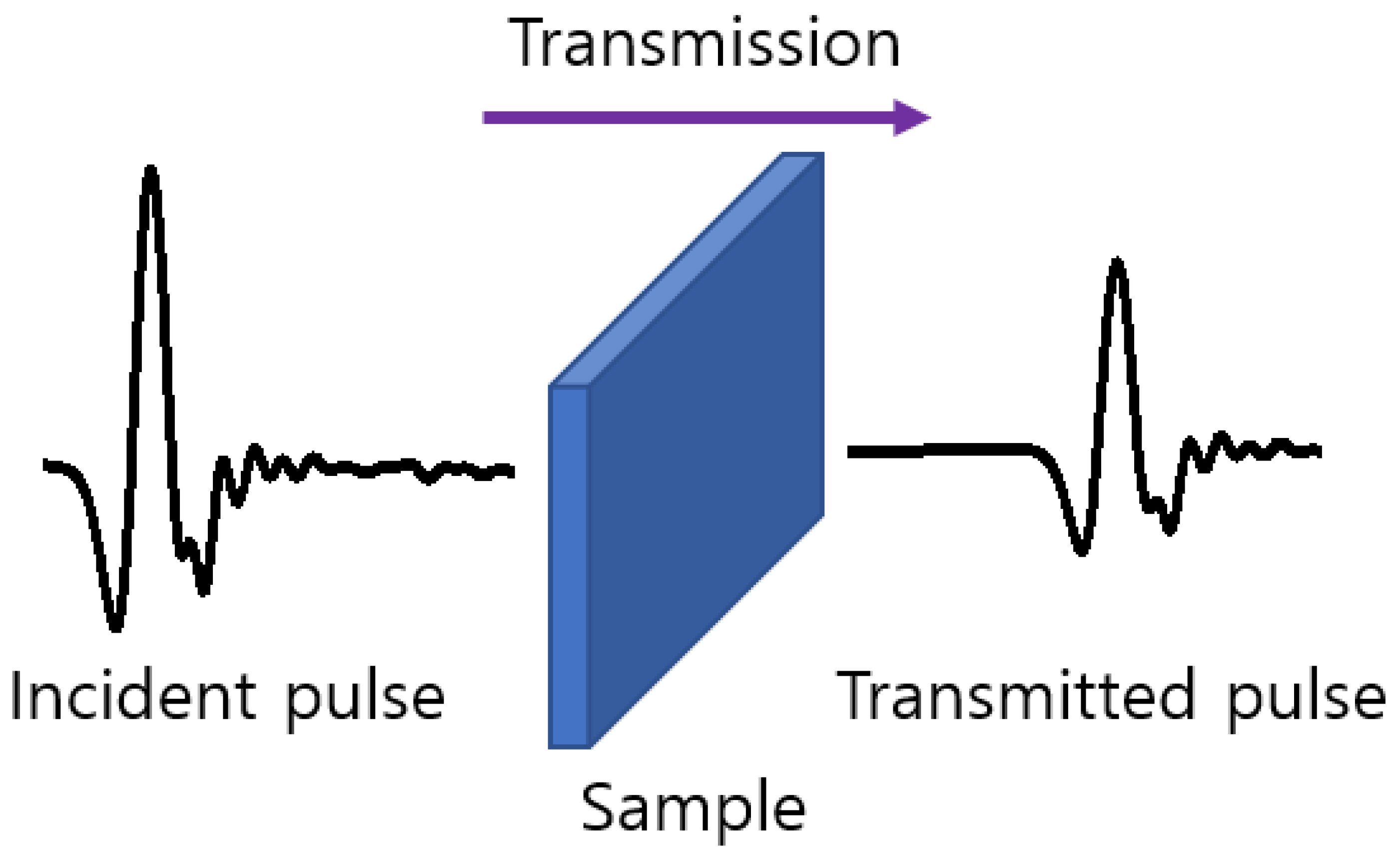

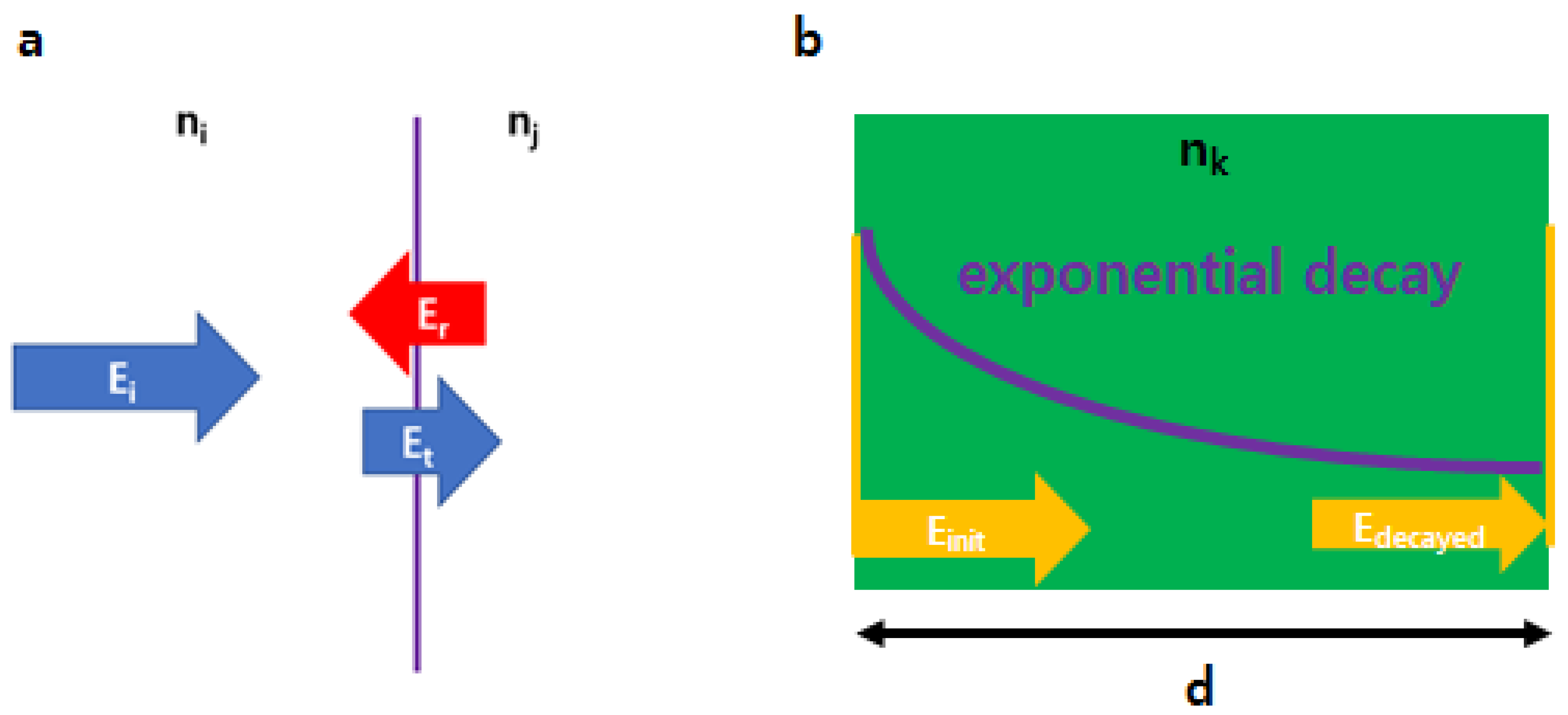


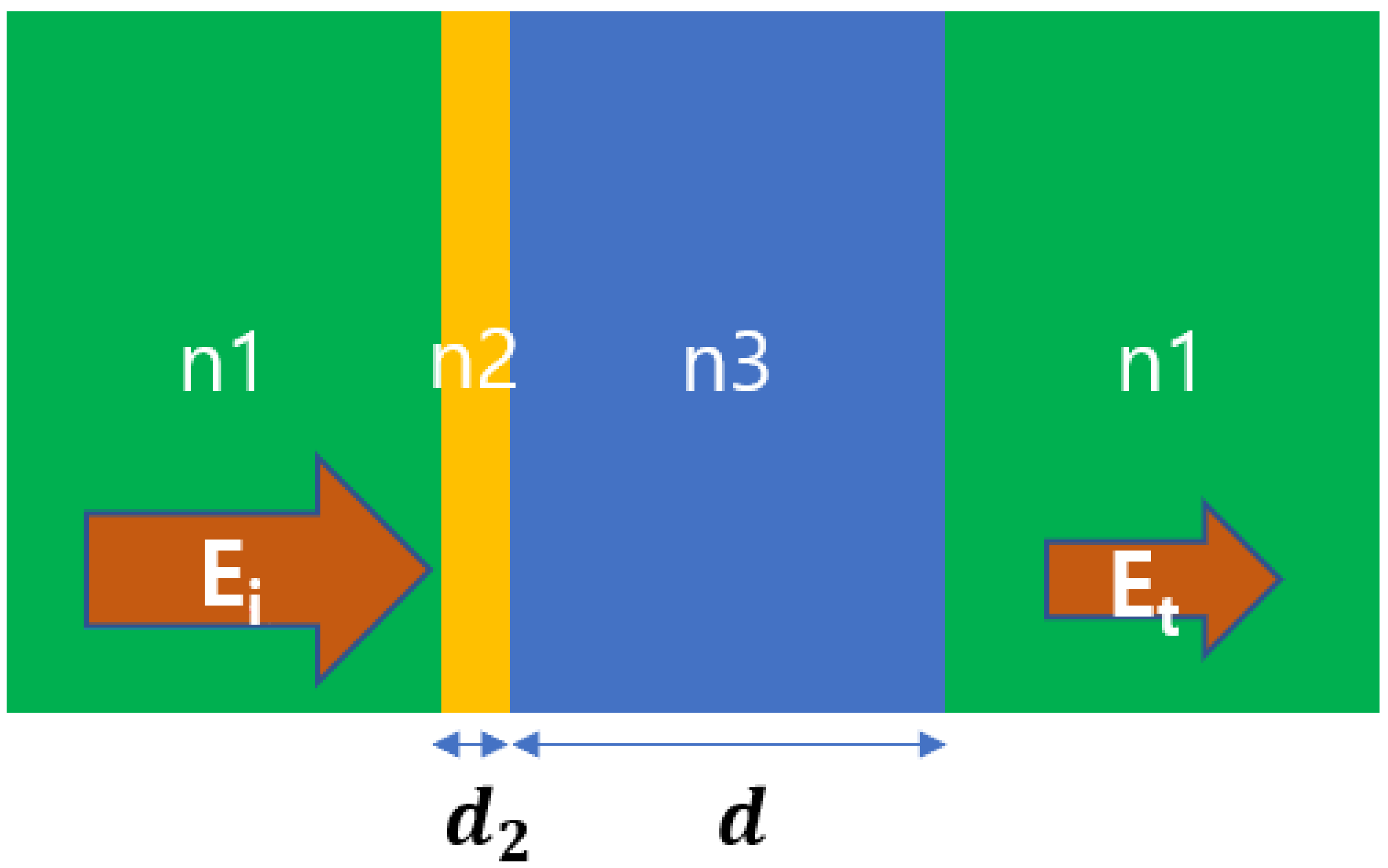

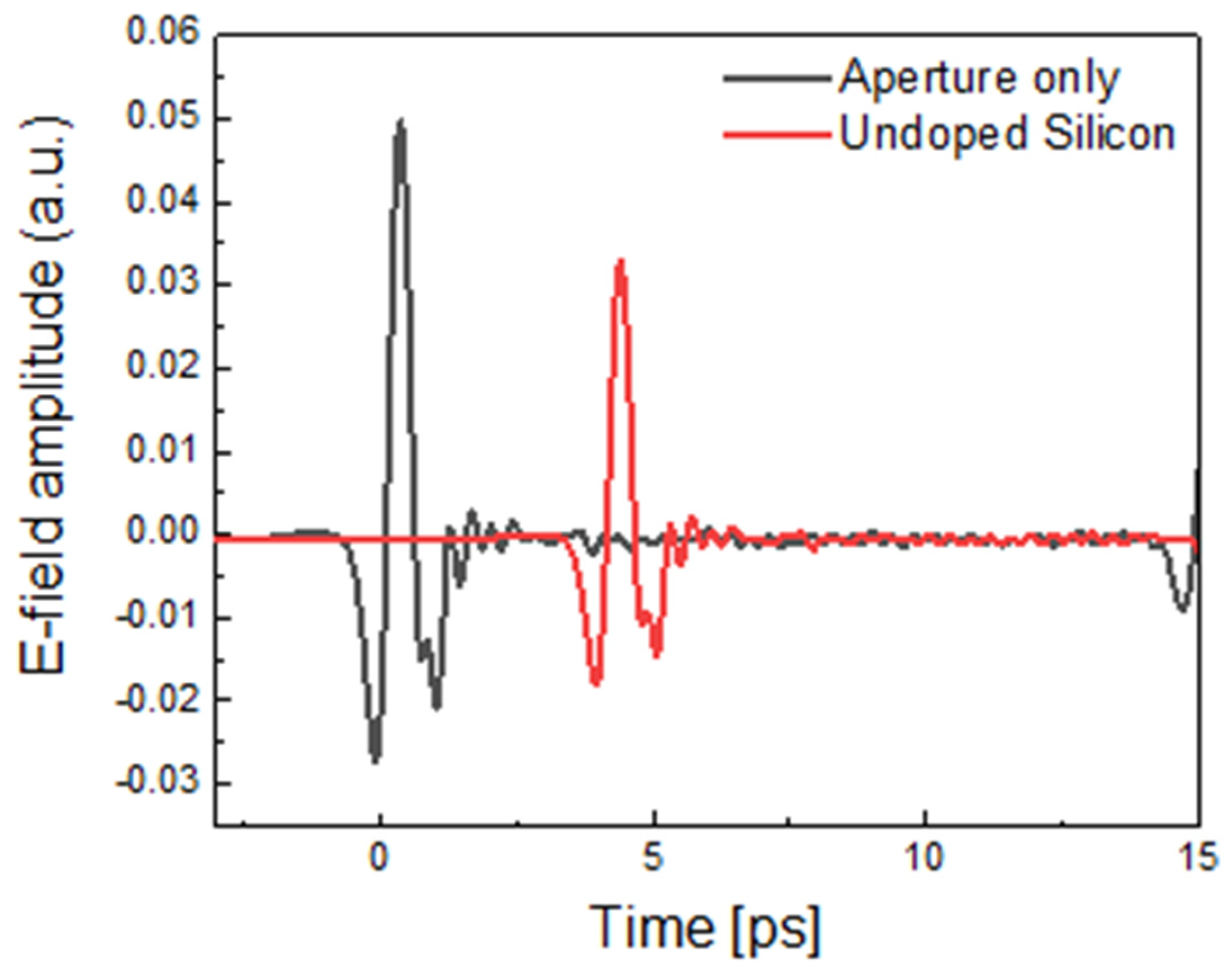
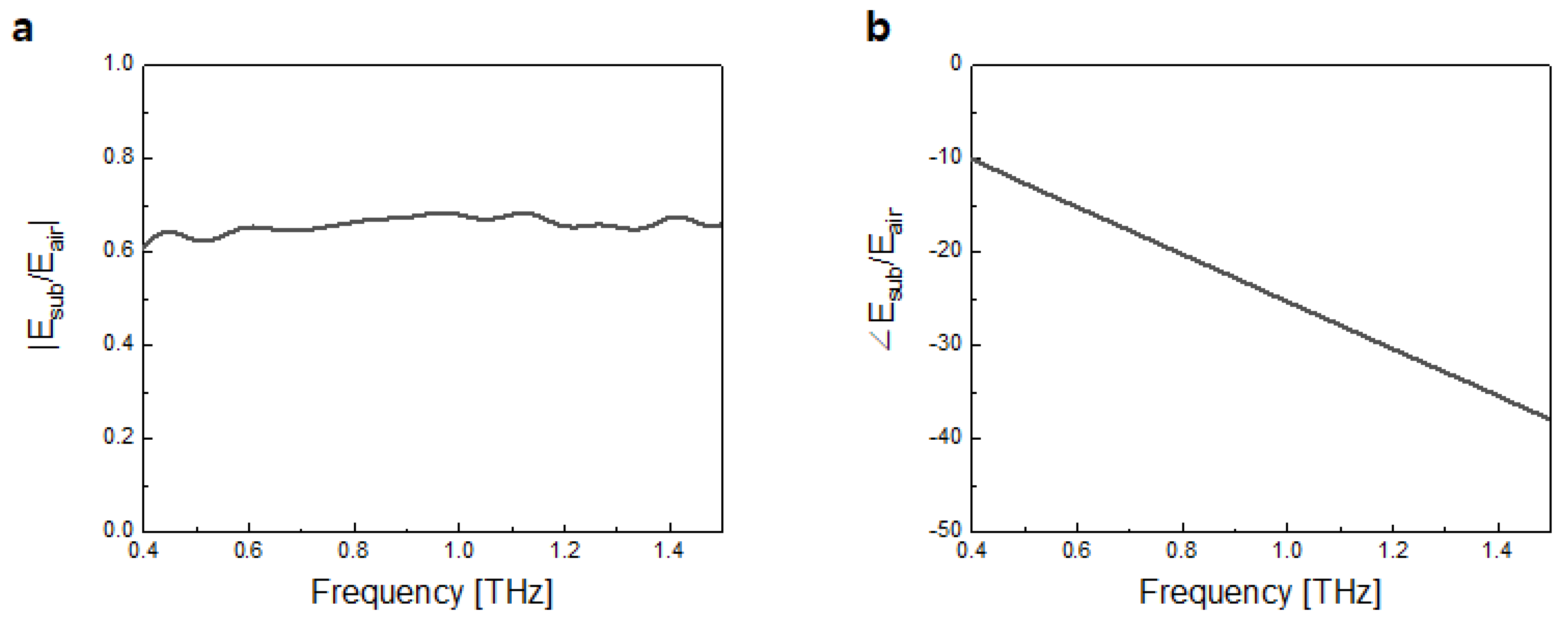

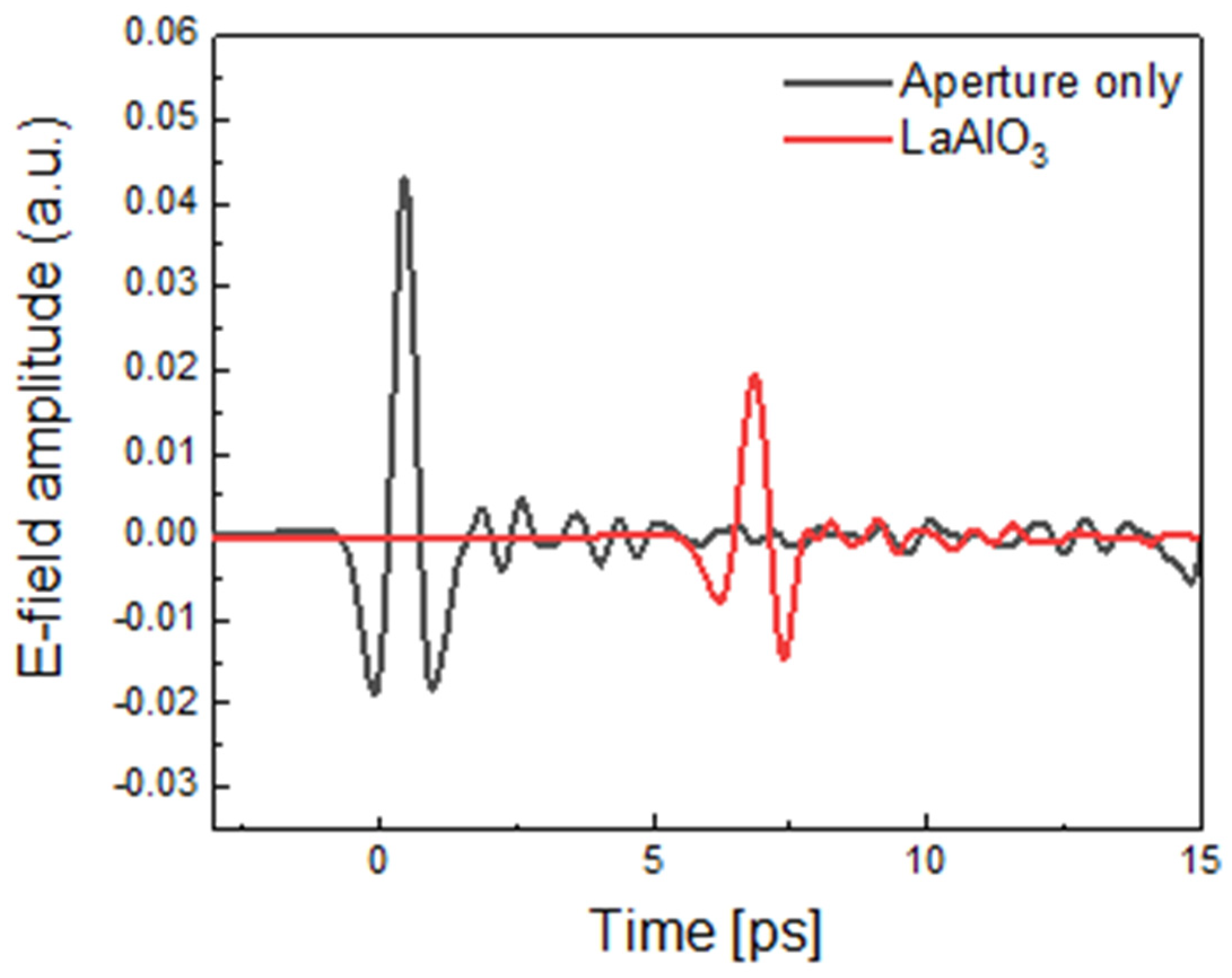
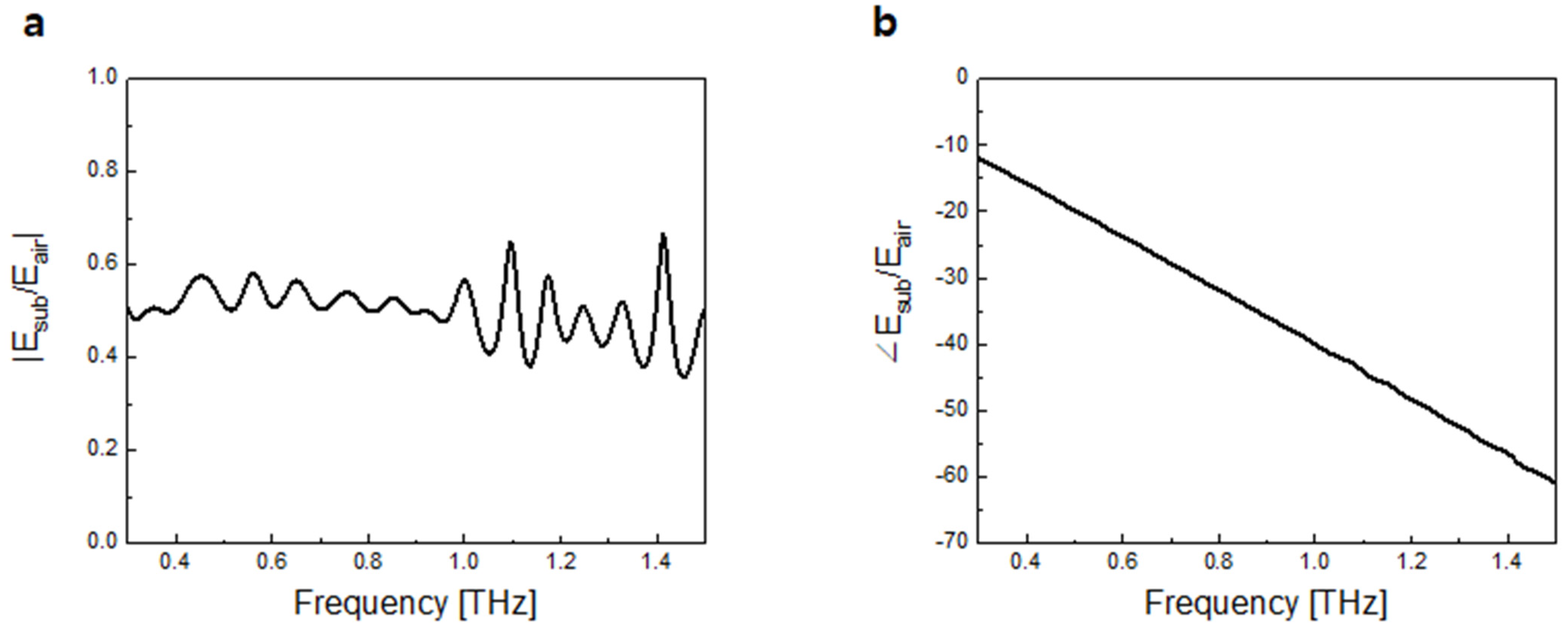
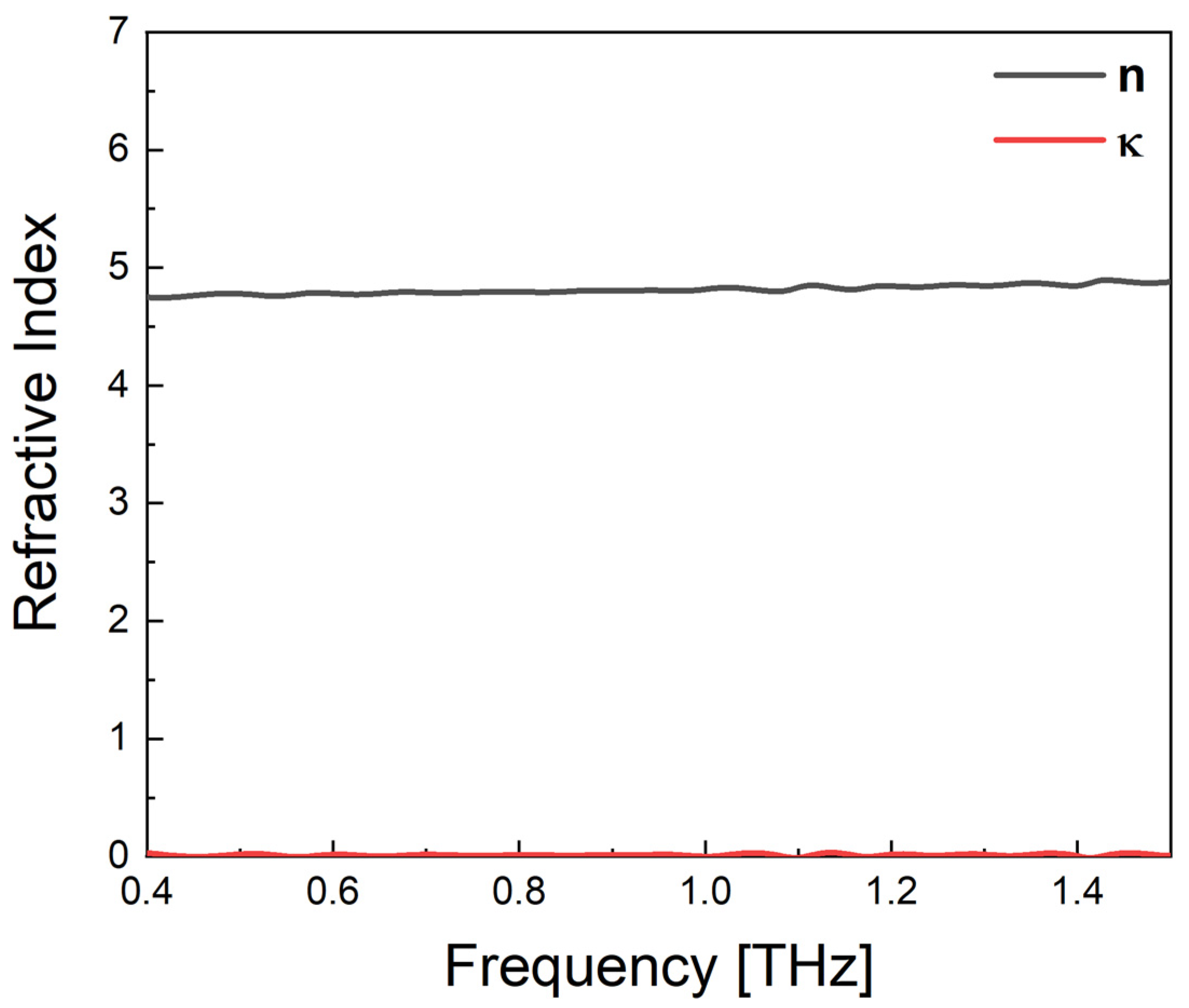
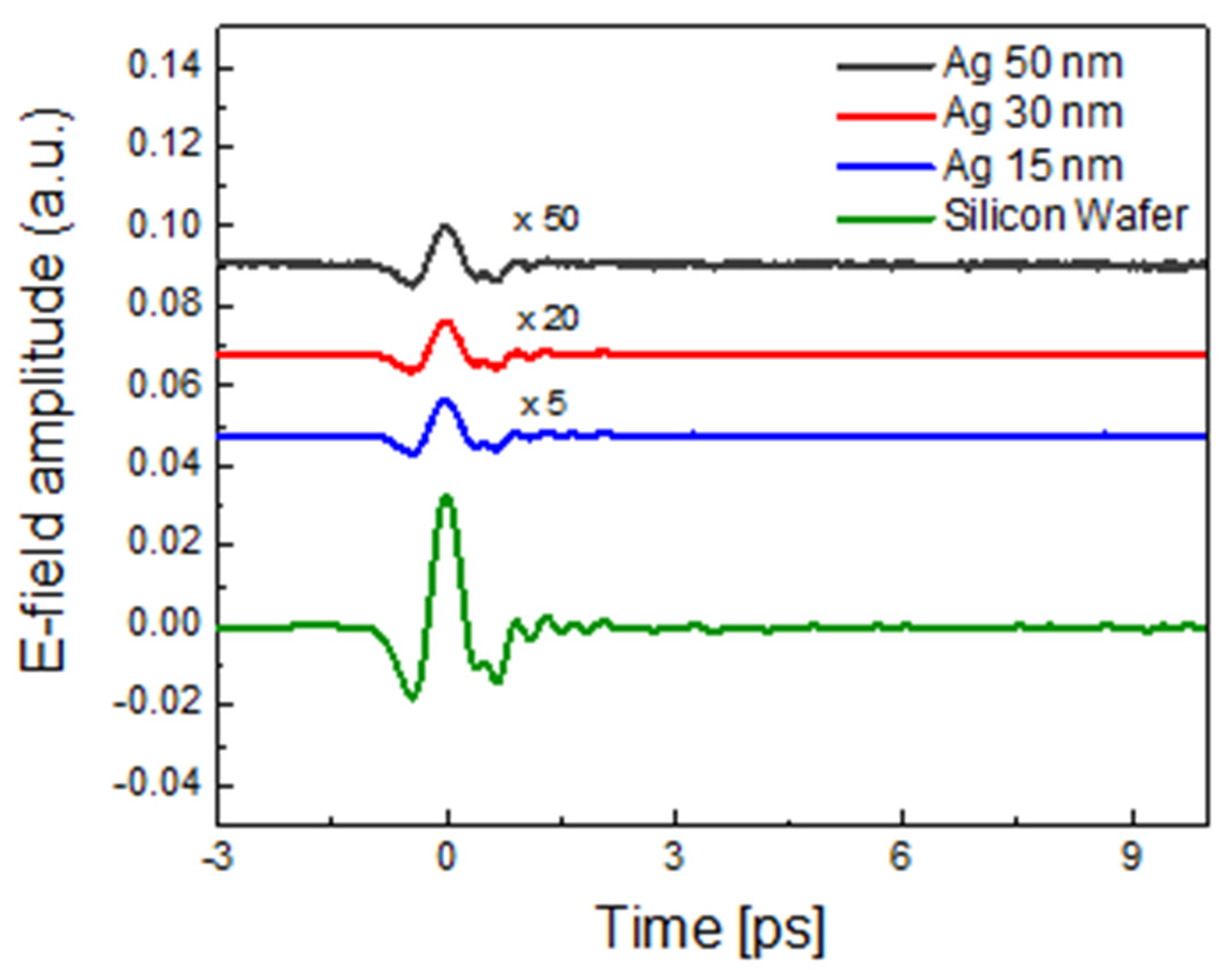
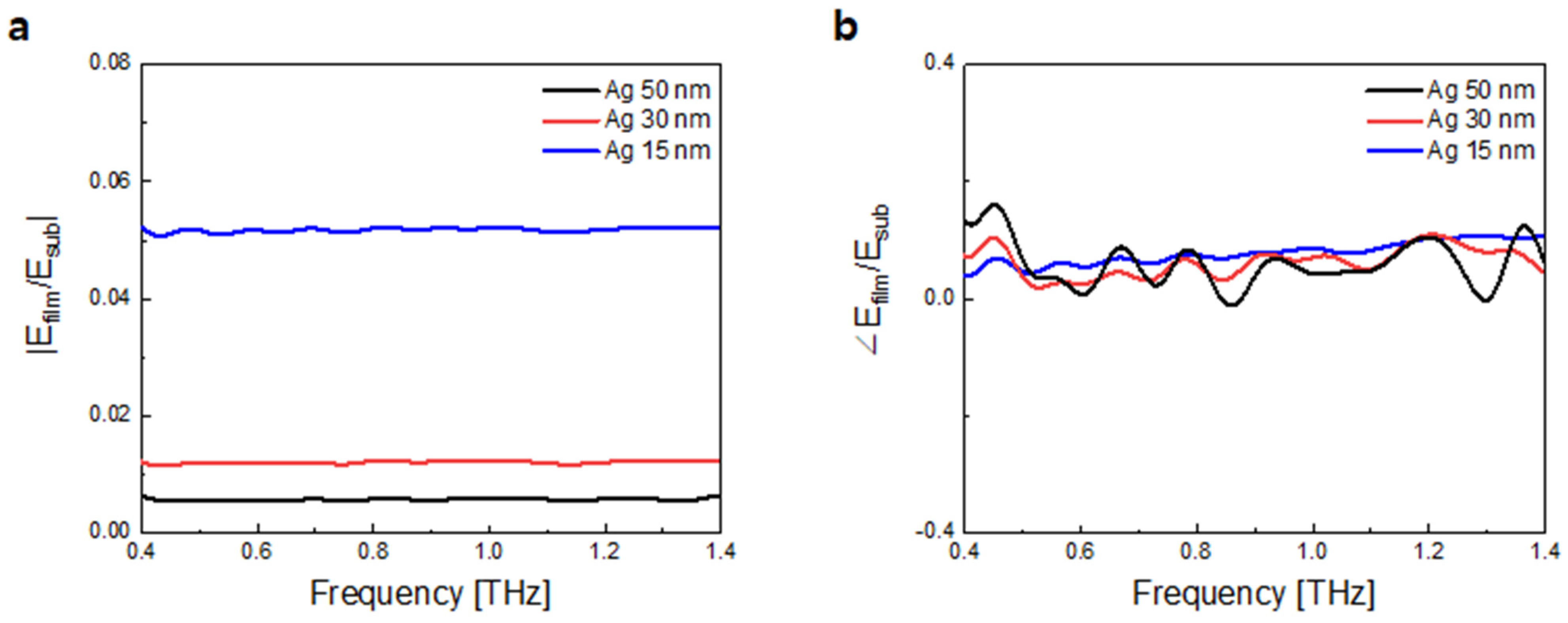


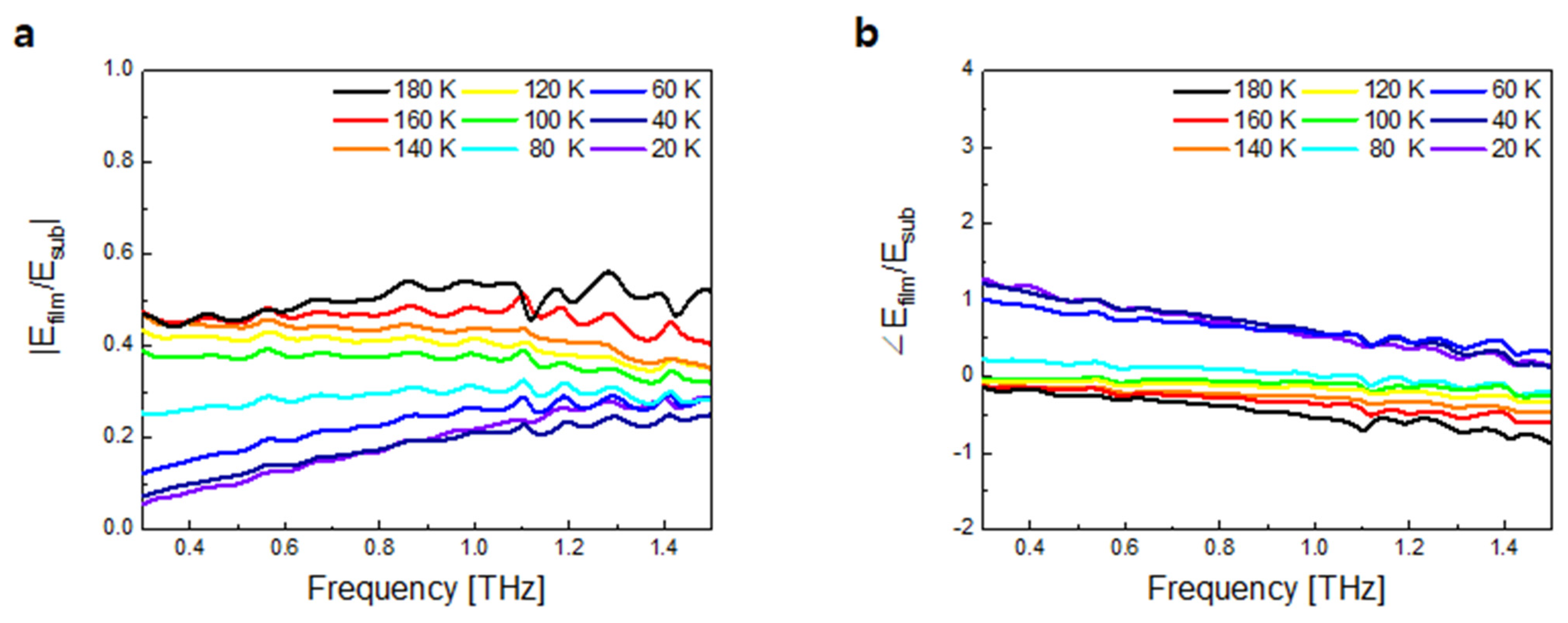
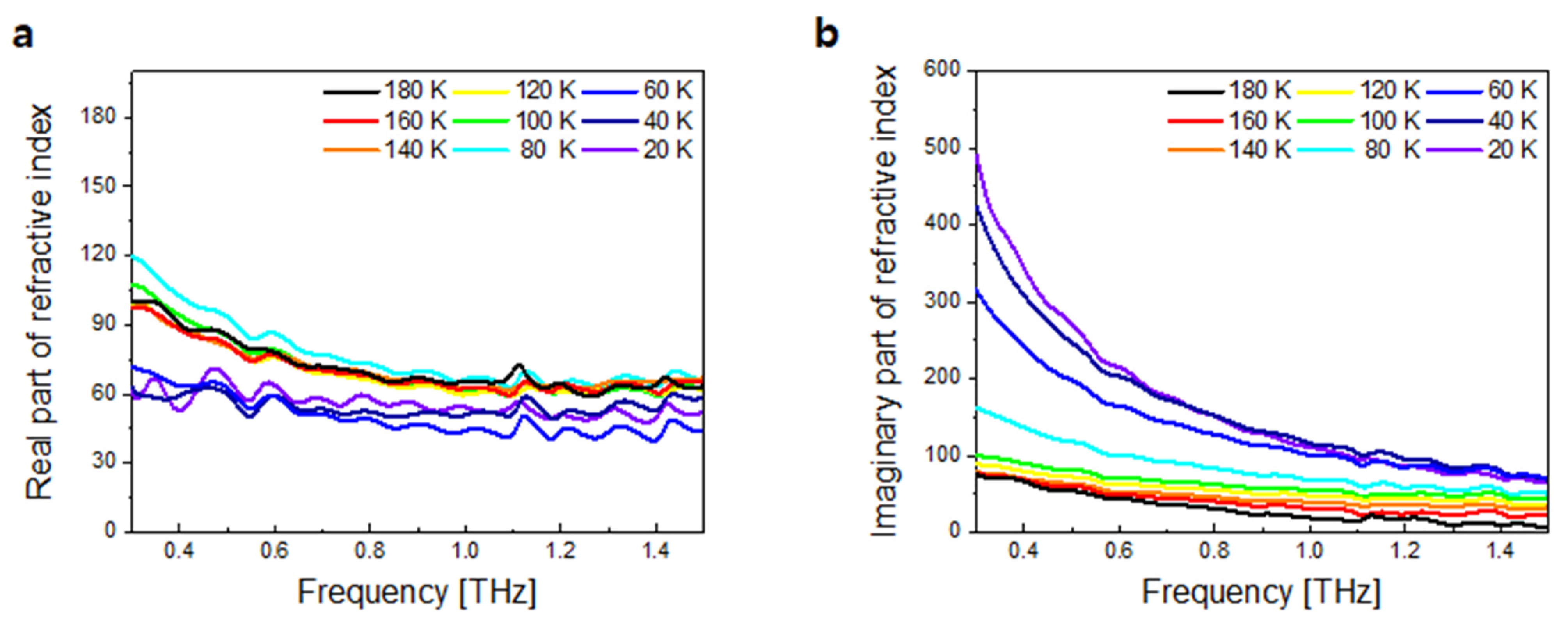
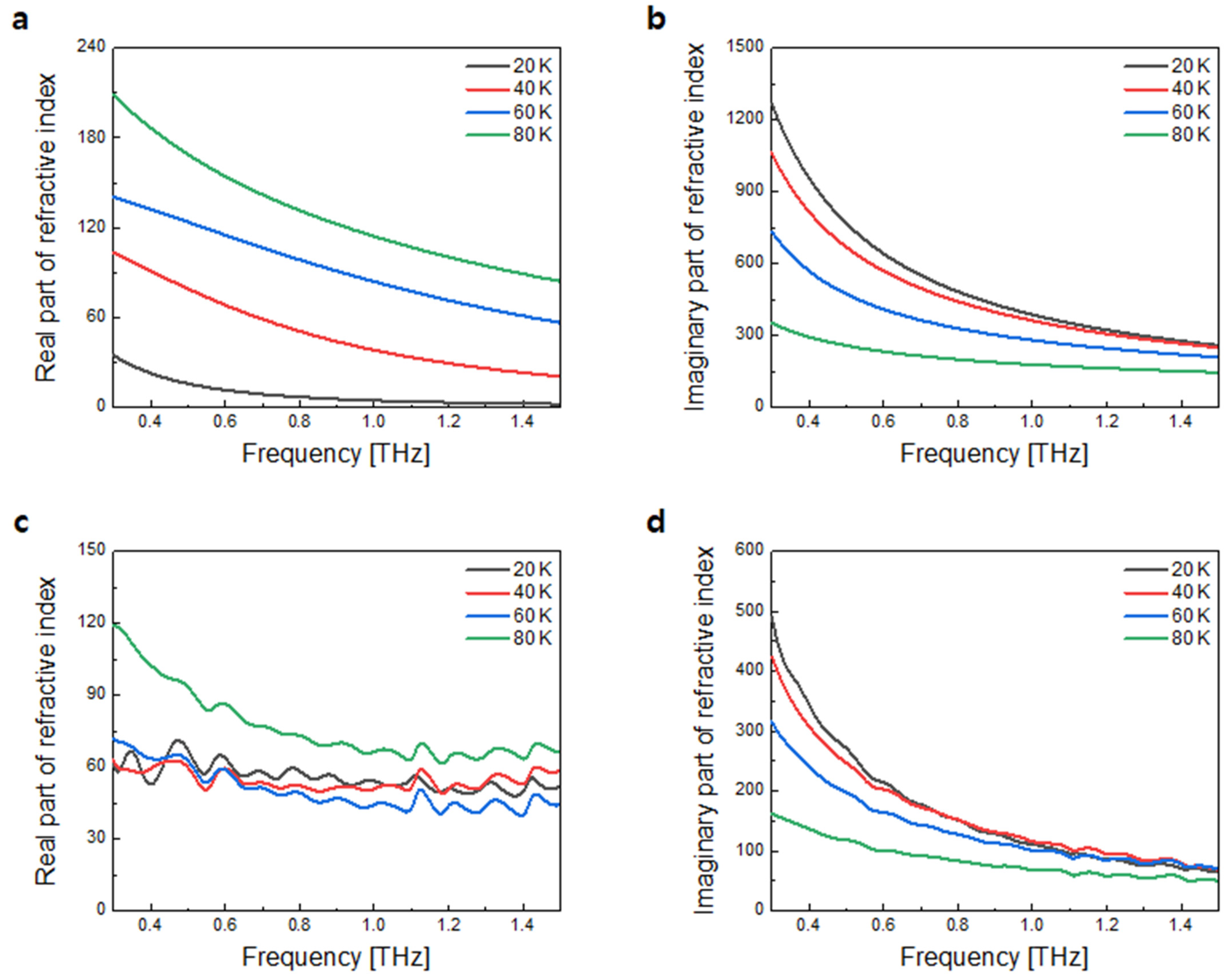
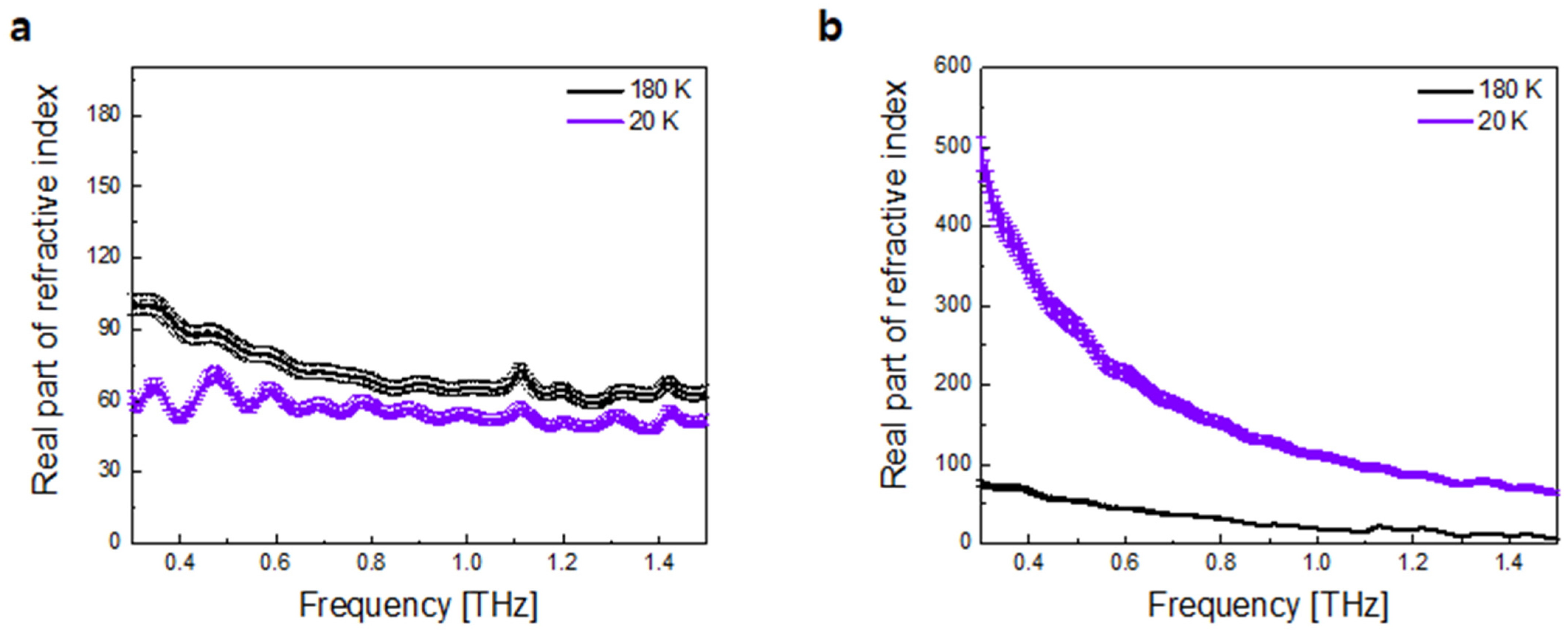
Publisher’s Note: MDPI stays neutral with regard to jurisdictional claims in published maps and institutional affiliations. |
© 2021 by the authors. Licensee MDPI, Basel, Switzerland. This article is an open access article distributed under the terms and conditions of the Creative Commons Attribution (CC BY) license (https://creativecommons.org/licenses/by/4.0/).
Share and Cite
Lee, H.-T.; Ji, G.-S.; Oh, J.-Y.; Seo, C.-W.; Kang, B.-W.; Kim, K.-W.; Park, H.-R. Measuring Complex Refractive Indices of a Nanometer-Thick Superconducting Film Using Terahertz Time-Domain Spectroscopy with a 10 Femtoseconds Pulse Laser. Crystals 2021, 11, 651. https://doi.org/10.3390/cryst11060651
Lee H-T, Ji G-S, Oh J-Y, Seo C-W, Kang B-W, Kim K-W, Park H-R. Measuring Complex Refractive Indices of a Nanometer-Thick Superconducting Film Using Terahertz Time-Domain Spectroscopy with a 10 Femtoseconds Pulse Laser. Crystals. 2021; 11(6):651. https://doi.org/10.3390/cryst11060651
Chicago/Turabian StyleLee, Hyoung-Taek, Gang-Seon Ji, Jun-Yung Oh, Choong-Won Seo, Byeong-Won Kang, Kyung-Wan Kim, and Hyeong-Ryeol Park. 2021. "Measuring Complex Refractive Indices of a Nanometer-Thick Superconducting Film Using Terahertz Time-Domain Spectroscopy with a 10 Femtoseconds Pulse Laser" Crystals 11, no. 6: 651. https://doi.org/10.3390/cryst11060651
APA StyleLee, H.-T., Ji, G.-S., Oh, J.-Y., Seo, C.-W., Kang, B.-W., Kim, K.-W., & Park, H.-R. (2021). Measuring Complex Refractive Indices of a Nanometer-Thick Superconducting Film Using Terahertz Time-Domain Spectroscopy with a 10 Femtoseconds Pulse Laser. Crystals, 11(6), 651. https://doi.org/10.3390/cryst11060651





